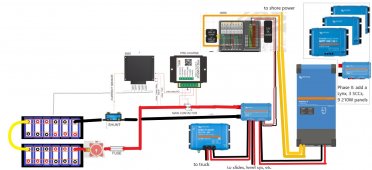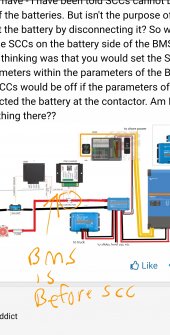BretS
New Member
- Joined
- Mar 30, 2021
- Messages
- 171
Copying this over here from beginners corner...
Drew up a rough plan for phase I of my 50A 5th wheel install. Using a MultiPlus 12/3000/120-50 2x120V Inverter/Charger, 930Ah DIY bank, REC active BMS/precharger, Orion DC-DC charger. Once that is in and working, and my bank account can handle it, phase II will be nine 210W panels and 3 Victron MPPT SCCs. The battery bank is split with a 4/0 AWG connecting them to make install a little easier and more flexible (fitting them under my steps in an open spot). Not every detail is covered, but do you see any major flaws in my plan? I realize the wire size will be large.
One question I have - I have been told SCCs cannot be switched off of the batteries. But isn't the purpose of the BMS to protect the battery by disconnecting it? So would you connect the SCCs on the battery side of the BMS contactor? My thinking was that you would set the SCCs to charge at parameters within the parameters of the BMS - that way, the SCCs would be off if the parameters of the BMS disconnected the battery at the contactor. Am I missing something there??
Drew up a rough plan for phase I of my 50A 5th wheel install. Using a MultiPlus 12/3000/120-50 2x120V Inverter/Charger, 930Ah DIY bank, REC active BMS/precharger, Orion DC-DC charger. Once that is in and working, and my bank account can handle it, phase II will be nine 210W panels and 3 Victron MPPT SCCs. The battery bank is split with a 4/0 AWG connecting them to make install a little easier and more flexible (fitting them under my steps in an open spot). Not every detail is covered, but do you see any major flaws in my plan? I realize the wire size will be large.
One question I have - I have been told SCCs cannot be switched off of the batteries. But isn't the purpose of the BMS to protect the battery by disconnecting it? So would you connect the SCCs on the battery side of the BMS contactor? My thinking was that you would set the SCCs to charge at parameters within the parameters of the BMS - that way, the SCCs would be off if the parameters of the BMS disconnected the battery at the contactor. Am I missing something there??




